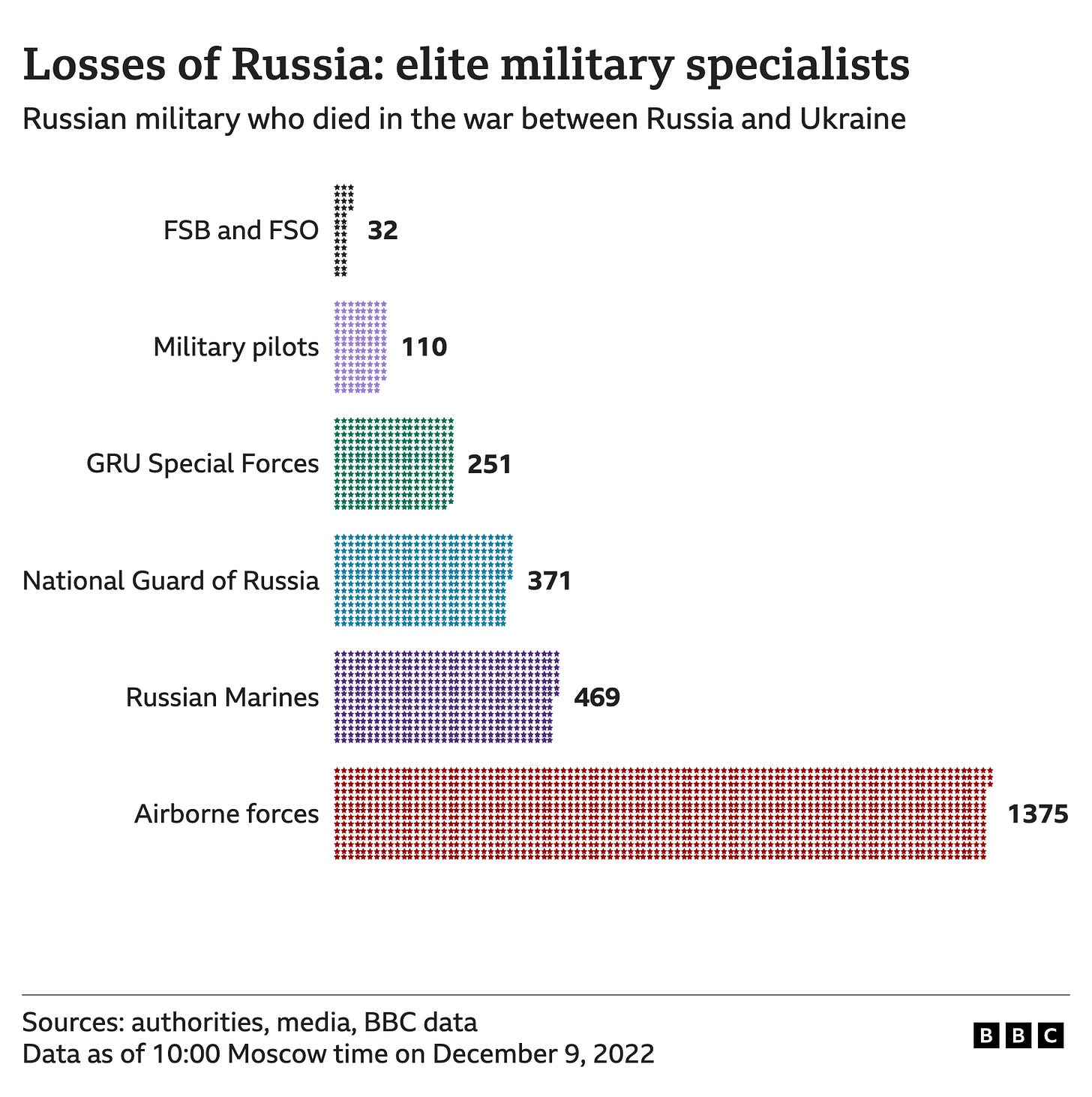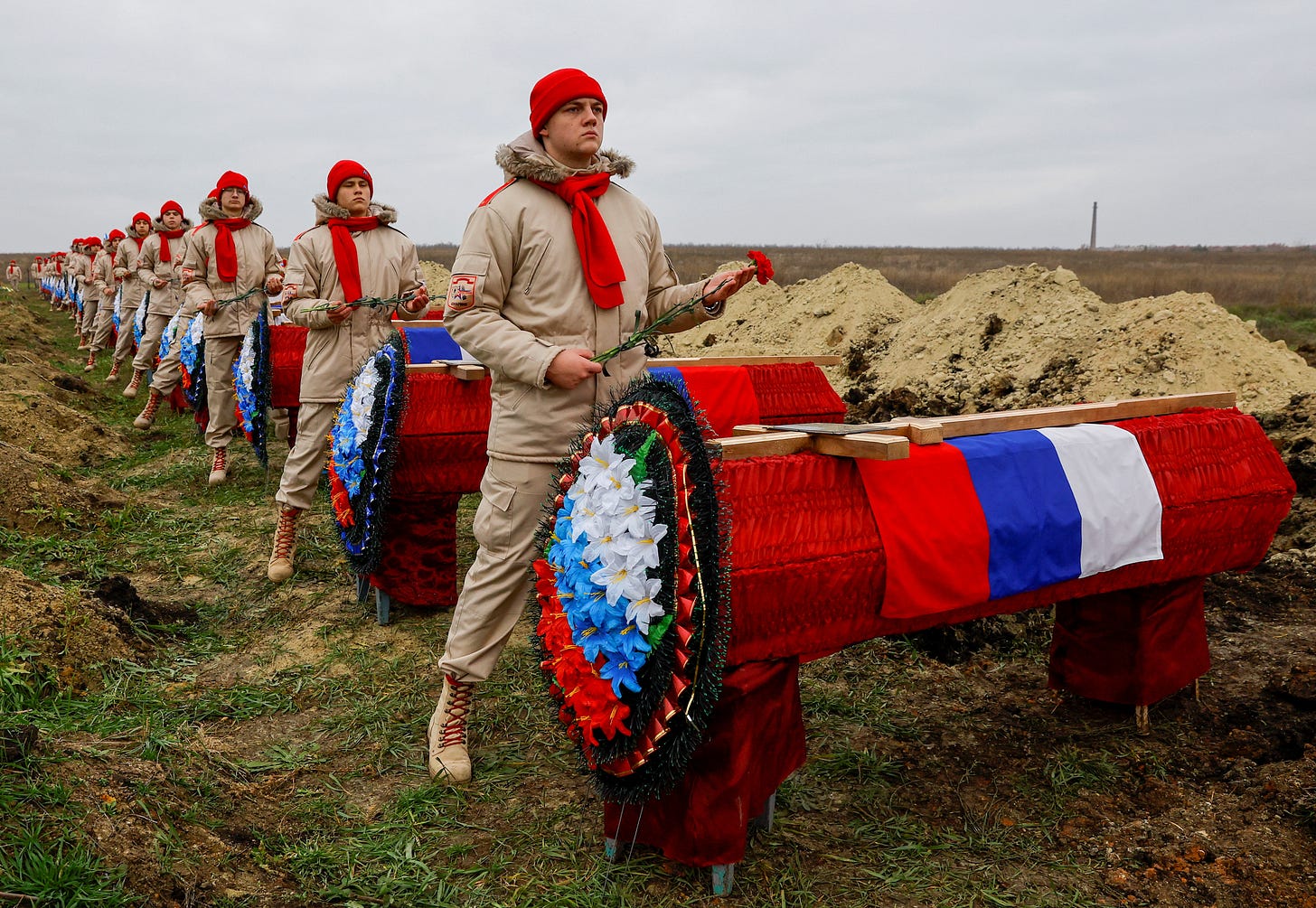10,000 names: what we know about Russian losses in Ukraine as of December
By Olga Ivshina

BBC Russian’s ongoing project counting Russia’s war dead in Ukraine has now reached over 10,000 confirmed names. These include over 400 newly mobilised recruits, and 95 serving prisoners. The new death toll also includes nine more fighter pilots and four more special forces officers. Krasnodar is now the region to have suffered the highest losses, followed by Dagestan and Buryatia.
Since the start of the war, BBC Russian, has been working with the media outlet ‘Mediazona’ and a team of volunteers, to keep a count of Russian casualties in Ukraine. As of December 9th, we have been able to confirm the details of 10,002 dead soldiers and officers.
We include only reported deaths that we have been able to confirm, so the collected data does not necessarily reflect the full extent of the casualties. We think that our list, at a lower estimate, contains 40-60% fewer names than the actual number of soldiers that have been buried in Russia. We came to this conclusion having studied monuments, memorial plaques, and cemetery records in over 60 Russian settlements.
Consequently, at a conservative estimate, Russian army and national guard casualties may be over 20,000 people.
More generally, Russian losses (including deaths and anyone missing or out of action because of injury) may be conservatively estimated to be at 90,000 people.
This figure is based on the observations of the United States Naval Institute, which estimates that for every Russian soldier killed in the war in Ukraine, there are another 3.5 injured. This figure does not include those who fought on Russia’s side as part of the ‘People’s Militia’ of Donetsk and Luhansk.
The deaths of mobilised men
We have identified a total 430 newly mobilised Russians killed in action since the mobilisation drive which began in September. This is 104 more people than two weeks ago.
Of those, we have been able to identify the names of 394 people that have died on the battlefield on Ukrainian territory. A further 36 died on Russian territory – usually because of heart problems, alcohol abuse, or other unforeseen circumstances.
The actual number of losses among mobilised soldiers may be far greater given that many reports of soldiers killed in Ukraine since October do not indicate the nature of their service in the armed forces.
There are several reasons for such significant losses among mobilised soldiers. Mobilised soldiers themselves have attributed the main problems to be bad coordination, signalling and cartographic problems, and inadequate training for new recruits.
Inequality between regions
Since the onset of winter, the largest number of confirmed casualties has been from Krasnodar region with 428 dead. 40% of the losses from this region were not reported in the media or on social media. News of their deaths only emerged from burial records in local cemeteries.
In second place for losses is Dagestan (363 people), in third place is Buryatia (356 people). By contrast, only 54 people from Moscow are known to have died, despite the fact that the capital’s inhabitants make up almost 9% of the country’s population.
On a surface level, these figures may seem to give the impression that the majority of people being sent to the frontline are from minority groups. But sociologists, who have studied our data, have drawn different conclusions.
On a proportional basis there are more people being sent to fight and die in Ukraine from national republics like Dagestan or Buryatia. But in absolute terms the largest proportion of Russian losses are ethnically Russian.
In all, the high risk of death for ethnic minorities is more likely to be the result of inequality between regions rather than a conscious and active policy of discrimination. In many corners of Russia, where there is very little social support, or other ways of earning money, serving in the army is one of the only ways to guarantee a stable income.
Losses among elite forces
Over the last two weeks, we have learned of the deaths of at least nine fighter pilots. These are particularly significant losses, as fighter pilots are a very specialised role and are considered elite forces in armies across the world.
Each pilot is trained for at least 10 years, at a cost of millions of dollars.
Other elite forces are also suffering losses. Since the start of December, four members of the Spetsnaz GRU have been killed, including one senior officer.
The loss of Spetsnaz officers is a hard pill to swallow for the Russian army, according to experts interviewed by the BBC. The qualifications needed to become a lieutenant take at least four years to attain. In order to assume command, a lieutenant also needs to gain sufficient experience, which takes about another four years. In all, experts reckon it takes at least eight years of preparation.
After nine months of war, the Spetsnaz GRU has lost over 250 people in total. Almost one in four was an officer.
Current losses in the Spetsnaz and the National Guard are comparable to, and in some cases are even higher than, the total losses these regiments suffered in 10 years of war in Chechnya. This is because elite forces are regularly asked to solve insurmountable problems.
For example, scouts are recruited to inspect and check the streets in captured settlements. The Russian National Guard are used for combined-arms battles and other defensive operations, despite having been specialized for completely different purposes.
Deaths of commanders
Of the 10,002 identified Russian soldiers that have died in Ukraine, 1,509 (15%) were officers. The dead also include four generals and 49 colonels.
In part, the high level of casualties among officers is due to the effective utilisation of Western high-precision long-range weapons, now in the possession of the Ukrainian army. HIMARS rockets repeatedly hit bases and command posts of the Russian military.
Another reason is the way the Russian armed forces are organised. According to experts, Russia entered the war with a shortage of both military equipment and well-trained personnel. As a result, throughout the war commanders have had to lead troops as though they were sergeants, personally leading them in attacks and defence, rather than directing military operations through a chain of command as would normally be expected.
Infantry, airborne troops, and prisoners
In the 10th month of war, the majority of losses – 17% – have come from the infantry.
Over the last months the number of losses among those who the Russian media refers to as ‘volunteers’ has significantly grown. They now make up 12% of total losses. In most cases these are people who of their own volition signed short-term contracts with the Ministry of Defence and the National Guard after the war began.
One of the reasons for high losses among volunteers is inadequate preparation. Hastily brought together detachments often go through only 3-10 days of training before being sent to the front.
The number of paratroopers being killed is now going down as more fighting is being done by mobilised soldiers and volunteers, most of whom join infantry units, and also by troops from private military companies – who include serving prisoners recruited direct from jail to boost their ranks.
As of 9th December, we identified at least 95 prisoners who have died fighting in various Russian military units. According to the fund ‘Rus sidyaschaya’ (‘Russia Behind Bars’) the number of prisoners recruited to fight in the war has exceeded 20,000 people.
What is known about the losses of the ‘DNR’ and ‘LNR’?
The total number of casualties on the Russian side significantly increases if we include people fighting in Ukraine as part of the ‘People’s Militia’ of Donetsk and Luhansk.
On 2nd December, the government of the self-proclaimed DNR acknowledged the deaths of 4,001 soldiers. The self-proclaimed LNR has not reported its losses, however based on available sources the figure can be put at over 1,000 people.
Even if we are just to factor in the above figures, the total number of casualties fighting on the Russian side exceeds 25,000 dead.
If we include the injured, general losses of pro-Russian forces can be put at over 112,500 people.
According to the USA, counting the dead and injured, Russian losses in Ukraine have exceeded 100,000 people.
The Ukrainian General Staff puts Moscow’s losses at 93,000 people. Russia’s Ministry of Defence last reported its losses on the 21st of September, announcing the deaths of 5,937 people.
How we get our data
In Russia, names and photographs from burials of the deceased are published daily. Usually, names are announced by heads of Russian regions or representatives of regional governments, local media, schools and places of learning where the deceased used to study, as well as family members.
The BBC, ‘Mediazona’, and a team of volunteers studies this data and adds it to a database which we have run since the start of the Russian invasion of Ukraine.
The names of 22 mobilised Russians who died before they were sent to the front are reliably known. Officials have also confirmed the deaths of a further 14 Russians but have not named them.
Read this story in Russian here.
Translated by Danny Booth.






